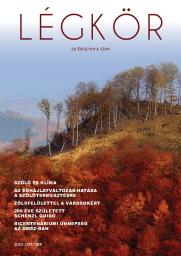LÉGKÖR - Quarterly Newsletter
Vol. 68, No. 4 * Pages 182–244 * October 2023
 |
|
 download [pdf: 21927 KB]
download [pdf: 21927 KB]
Evolution of viticultural climate indices from the beginning of the last century in the area of the Sopron wine region
Bokros Kinga, Lakatos Mónika
DOI:10.56474/legkor.2023.4.1 (pp. 182–189)
Bokros Kinga, Lakatos Mónika
DOI:10.56474/legkor.2023.4.1 (pp. 182–189)
Investigation of the potential effects of climate change on grape growing nationwide, based on long data series
Varga Zoltán
DOI:10.56474/legkor.2023.4.2 (pp. 190–196)
Varga Zoltán
DOI:10.56474/legkor.2023.4.2 (pp. 190–196)
Choosing the time of grape harvest in 18th-century Jazygian District
Vincze János Farkas
DOI:10.56474/legkor.2023.4.3 (pp. 197–203)
Vincze János Farkas
DOI:10.56474/legkor.2023.4.3 (pp. 197–203)
Improving urban living environment with green structures 2.
V. Horn Valária
DOI:10.56474/legkor.2023.4.4 (pp. 204–209)
V. Horn Valária
DOI:10.56474/legkor.2023.4.4 (pp. 204–209)
LÉGKÖR - Quarterly Newsletter
A folyóirat nyomtatott változata megrendelhető a legkor@met.hu címen.
Kapcsolat: legkor@met.hu
SZERKESZTŐBIZOTTSÁG
SZERZŐI ÚTMUTATÓ
Kapcsolat: legkor@met.hu
SZERKESZTŐBIZOTTSÁG
SZERZŐI ÚTMUTATÓ









